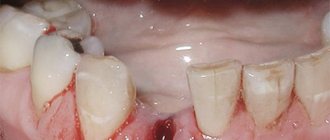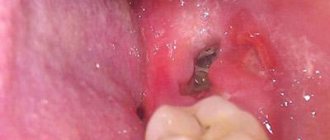Fibrosing alveolitis
This type of pathology is notable for the fact that connective tissue develops to replace the necrotic residue of the hole left after tooth extraction. In principle, many dentists propose to consider fibrosing alveolitis not as a separate type of this nosology, but as one of the stages of its course, which is characterized by a slight decrease in the intensity of the manifestations of the inflammatory reaction and partial stabilization of the general condition of the patient. If you take a closer look at the condition of the oral cavity, you will notice a slight proliferation of soft tissues adjacent to the hole in which the pathological process occurs. The formation of a gap between the soft tissues and the hard, bone wall is also typical in this situation.
Causes
Disruption or flushing out of a blood clot occurs when rinsing the mouth after tooth extraction. The opinion of patients that if you rinse with antiseptics, the wound will heal faster is wrong. They are much more likely to lead to a “dry socket” and problems with it than to speed up rehabilitation after tooth extraction. Only oral baths are acceptable.
In addition to improper rinsing, the causes of alveolitis consist of the following factors:
- Weak immunity;
- poor blood clotting;
- failure to comply with the surgeon's requirements after surgery;
- ingress of bone remains or particles of crumbled teeth into the wound;
- insufficient treatment of the hole (if pieces of the root, cystic tissue, areas of granulation remain).
You can quickly cope with the disease if you make a diagnosis at the earliest stages of development. That's why it's so important to pay attention to its signs.
Allergic alveolitis
When compounds that cause a pathological reaction in the form of an allergy enter the human body, not only the respiratory tract and the mucous membrane of the eyes react - swelling and soreness of the dental alveoli with the subsequent formation of an inflammatory process can sometimes also be noted. Accordingly, all these changes can safely be called allergic alveolitis, because their pathogenesis is based on the same antigen-antibody reaction.
This type of pathology is manifested by constant aching pain, which intensifies significantly during food consumption. Quite rightly, allergic alveolitis is recognized as one of the “mildest” forms of this disease, because it is not accompanied by a pronounced clinical picture. Usually the patient's general condition is relatively satisfactory, there is no fever. Upon careful examination of the hole left after tooth extraction, one can note the almost complete absence or insufficient amount of a protective blood clot. Remnants of food are usually visible here. It may also be that allergic alveolitis forms after 2-3 days from the moment of tooth extraction. And if timely treatment is not started, the prognostically favorable form of the disease can lead to serious complications.
Alveolitis of the tooth: treatment
The treatment of alveolitis after tooth extraction must be taken seriously, since the disease will not go away on its own, and its consequences can be very serious:
- blood poisoning
- abscess
- osteomyelitis
- phlegmon
- periostitis
Only an experienced dental surgeon will create an effective treatment plan. It is better to start it when the first signs of the disease appear. The treatment process may include:
- numbing the affected area using anesthesia
- washing the hole with warm antiseptic solutions
- removing particles of tissue decay that remain after washing using a sharp surgical spoon
- treatment with a sterile cotton swab
- applying a gauze bandage with iodoform impregnation or an anesthetic and antiseptic bandage
- impregnation of soft tissues at the site of inflammation with anesthetic and lidocaine
- application of antiseptic tampons, hemostatic sponge with kanamycin
- removal of dead tissue
- microwave therapy, fluctuarization, infrared laser beams, ultraviolet irradiation
- prescribing vitamins, analgesics and sulfa drugs
- antibiotic therapy
With proper treatment of serous alveolitis, the inflammatory process subsides after 3–4 days.
A week after the pain disappears, the walls of the socket begin to heal and become covered with new mucous tissue. After 14 days, the swelling subsides and the mucous membrane takes on a normal pink color. After treatment of purulent alveolitis, the wound heals within 1–2 months, and tissue restoration takes about six months.
Idiopathic alveolitis
If alveolitis has already developed, then you need to rush to take action, and not find out the reason why this happened. Yes, this is one of the diseases in which understanding the pathology of the process is not of primary importance, because regardless of what exactly caused the pathological process, treatment regimens will differ little from each other. The tactics of patient management are determined not by the origin of alveolitis, but by the severity of clinical symptoms.
It is not a fact that alveolitis arose due to a medical error - individual anatomical features could be the only factor that provoked the occurrence of such a situation. Take, for example, the same alveolitis after the extraction of a wisdom tooth - due to the difficulties with removing the “eights” itself, the likelihood of complications occurring is quite high. By the way, it is precisely the anatomy of the root system of wisdom teeth that causes the removal of a dental cyst most often to be carried out on the eighth molars.
Diagnostics
A dentist can recognize alveolitis and confirm the diagnosis based on the patient’s complaints and the results of an external examination of the oral cavity. Upon examination, a protracted healing process of the hole at the site of tooth extraction and the absence of a blood clot are discovered. In the chronic form of alveolitis, the socket is without granulation tissue, and the bone is visible.
More detailed information about the condition of the tissues can be obtained by radiography and radiovisiography (computer radiography) at the site of the extracted tooth.
Exogenous alveolitis
A persistent febrile condition is characteristic; throughout the entire disease there is pronounced pallor of the skin. The patient's quality of life deteriorates significantly - he cannot eat properly, because it becomes very difficult to eat.
Lymphangitis and lymphadenitis are characteristic signs of exogenous alveolitis, because the infection quickly spreads to nearby areas. Upon visual examination, a gray coating and severe hyperemia are noted, and upon palpation the patient notes sharp pain.
Symptoms
After tooth extraction, intense pain normally persists throughout the day. As healing progresses, the severity of pain decreases and completely disappears within 1–3 days. With alveolitis, on days 3–5, severe throbbing pain is felt at the site of the extracted tooth. As the infectious-inflammatory process progresses, the pain intensifies and spreads to the affected half of the face.
When examining the oral cavity, hyperemic (reddened) swollen gums are discovered. The blood clot in the socket is absent or partially preserved, covered with a gray coating. On palpation, the submandibular lymph nodes are enlarged.
The general condition is aggravated by the toxic-infectious syndrome:
- weakness,
- increased fatigue,
- low-grade fever.
Patients complain of an unpleasant taste in the mouth, bad breath, and increased salivation. Due to constant pain, appetite decreases and night sleep is disturbed. Teeth hypersensitive to cold and hot food.
Post-extraction alveolitis
In this case, the name of the pathology indicates its direct origin - it is easy to guess that post-extraction alveolitis develops as a result of unsuccessful (complicated) tooth extraction. This variant of alveolitis involves inflammatory tissue damage not only to the socket itself, but also to the adjacent gum. The statistics of complications is impressive - even taking into account the potential of modern medicine, the incidence of post-extraction alveolitis is about 40% of cases, and most of them are associated with interventions performed on the lower molars.
The clinical picture of post-extraction alveolitis occurs 2-3 days after tooth extraction. Symptoms can be conditionally classified into two variants of manifestations - symptoms of general and local significance. Alveolitis necessarily has symptoms from both the first and second categories.
The first category includes:
- Low-grade or febrile fever.
- Lymphangitis and lymphadenitis (regional);
- Halitosis.
Manifestations related to the second category are:
- Local hyperemia and swelling.
- Lack of protective blood clot.
- The presence of a gray coating on the hole.
- Separation of pus.
- Local pain syndrome.
In this case, alveolitis treatment requires primarily symptomatic treatment.
An important point that must be taken into account when diagnosing post-extraction alveolitis - for the reason that the possibility of provoking the development of the disease by the remaining piece of tooth cannot be excluded, the patient must be referred for an x-ray. It may be that even if alveolitis develops, the symptoms of this disease do not indicate the presence of pathology for a certain period of time.
Many patients consider the occurrence of alveolitis to be solely the fault of the doctor, because there are articles that write that the socket can become inflamed as a result of improperly carried out preventive measures after tooth extraction. Yes, such cases happen, but not in the Academy Dent clinic - the use of modern techniques, coupled with the highest professionalism of our doctors, allows pain relief and removal without any consequences for the patient.
The worst option is when the tooth is not completely removed and some part of its root remains in the socket. This situation, without a doubt, is the fault of the doctor, because he was not convinced that the intervention was performed correctly and did not study the anatomy of the root system of the tooth using an x-ray. Severe purulent inflammation develops - body temperature rises, purulent discharge with an unpleasant odor is noted. The patient complains of a specific sensation of something sweet in the mouth - but in fact, the inflammatory process is to blame. Therefore, it is very important to ensure that after tooth extraction there are no foreign bodies left in the socket - in this case, their imperceptible resorption by cells of the immune system is a priori impossible.
The process in question, which occurs in one place, can easily inflame several adjacent holes, as a result of which eliminating the problem will become much more difficult. It will be necessary to drain the purulent lesion and use strong antibiotics administered orally. Alveolitis often requires surgical treatment, with dissection of the adjacent subcutaneous fat.
How to treat alveolitis after tooth extraction
It happens that the empty socket becomes inflamed after tooth extraction , the temperature rises, and an unpleasant odor is heard from the mouth. And all this “happiness” lasts up to two weeks. If these symptoms are familiar, then most likely you are dealing with alveolitis.
Alveolitis is inflamed socket walls with reduced protective properties, which can occur as a result of alcohol intake, or a traumatic tooth extraction operation, or improper oral care, or if the integrity of a blood clot is violated by the patient. Also, one of the reasons may be an inflammatory process as a result of the development of an infection that is located in the socket of a diseased tooth, especially if it is removed due to exacerbation of periodontitis, or complications of periodontitis. Against this background, a general decline in immunity, characterized by the patient’s age, and previous illnesses can play a negative role.
Sometimes alveolitis after tooth extraction can lead to suppuration of the affected area, and at the same time to necrosis of the affected tissues of the oral cavity. Signs of alveolitis after tooth extraction, in the opinion of the vast majority, are very harmless. Something like “it hurts and it goes away.” This is not true, in its neglected form, this disease can deprive teeth in the literal sense of the word.
Alveolitis after tooth extraction symptoms
The disease is characterized by the presence of pain in the socket of the extracted tooth, which only increases during meals, but never disappears. The rest of his health, including body temperature, is completely normal. The hole itself may be filled with a blood clot, there may also be food particles and saliva secretions there. The mucous membrane of the gum itself becomes inflamed red, and touching it causes discomfort.
If at this stage of development you do not seek help from a specialist, then in the future, the pain will move to the ear, temple, and to the part of the head where the affected area is located. At the same time, the state of health will no longer be characterized as normal, the body temperature rises, eating due to pain becomes more difficult from time to time, and the hole itself will be covered with a gray coating with a pronounced unpleasant odor. The lymph nodes under the jaw swell, and also cause pain when moving the jaw, and swelling forms on the face. Also, alveolitis itself can cause a number of other, no less unpleasant diseases.
Treatment of alveolitis after tooth extraction
To cure this disease, you should remember one important rule - no amateur activities. Only a doctor can provide truly effective assistance, and no one else. Folk remedies will remove the symptoms, but will not make the disease go away.
The doctor himself will begin the treatment directly - under local anesthesia, the treatment of the hole will begin. With the help of a syringe and an antiseptic, everything unnecessary is washed out of it - saliva, food, clots, pus. Next, with a surgical spoon they remove everything that could not be removed. After this, the hole is again treated with an antiseptic, dried, and closed with a gauze strip soaked in an antiseptic and anesthetic. If alveolitis is in the initial stage, then after treatment the pain does not return, and the inflammatory areas resolve within a couple of days. The main thing is not to let pus appear in the hole; in this case, even with active treatment, the pain will not go away.
Treatment of alveolitis
Treatment of alveolitis, regardless of its etiology, is a very difficult task, the solution of which clearly requires professional medical care. In no case should you act independently and at home, because with an illiterate approach there is a high chance of causing significant harm.
Conditionally, the treatment of alveolitis can be classified into stages - depending on how timely the alveolitis was diagnosed, the treatment and general management tactics are determined.
Early treatment
If alveolitis was diagnosed in the initial stages, then to get rid of the disease it is sufficient to perform the following measures:
- The implementation of drug anesthesia is primarily because, despite its relative simplicity, the process of getting rid of alveolitis is quite painful.
- Treatment of the hole in which there is an inflammatory process is washed with an antiseptic solution.
- Removing necrotic debris from the socket.
- Repeated treatment of the hole with an antiseptic followed by drying with gauze.
- Placement on top of fabric soaked in antiseptic and drugs that provide an anesthetic effect.
- Apply applications with antiseptics daily (for a week) in order to eliminate the possibility of a relapse of the inflammatory reaction.
Stages of alveolitis
All these symptoms of alveolitis cannot appear at the same time. Signs of the disease accumulate, alternate, or overlap as inflammation progresses. Symptoms help determine the stage of the disease.
Serous alveolitis
It develops 72 hours after tooth extraction. The main symptom is aching pain that intensifies while eating. Body temperature is not elevated, regional lymph nodes are not enlarged. Upon examination, pieces of food and saliva are found in the hole, but there may not be a blood clot there, or it may be partially destroyed. Serous alveolitis continues for a week, and if left untreated, it turns into a purulent form.
Purulent alveolitis
Occurs 10 days after tooth extraction. By this time, the pain from alveolitis has already become so intense and constant that it is impossible to eat. In this case, unpleasant sensations spread along the branches of the trigeminal nerve. The soft tissues of the affected area swell, and mouth opening is limited. The patient feels weak and unwell, his temperature rises (up to 38 degrees) and a putrid taste and smell appears in the mouth. Upon examination, you can see redness, swelling, a dirty gray coating, and the alveolar process is thickened on both sides of the socket.
Chronic purulent (hypertrophic) alveolitis
As the disease becomes chronic, the pain begins to gradually subside, body temperature normalizes, and the patient’s general condition noticeably improves. The soft tissue in the area of the inflamed hole grows, and pus is released from it. The gums at the site of inflammation are swollen and have a bluish tint.
Alveolitis can occur not only in adults, but also in children. If a child has had a permanent tooth removed, parents need to carefully monitor compliance with the doctor’s recommendations.
Causes of complications and pain with alveolitis
Alveolitis after tooth extraction usually develops in the following cases:
- Difficult removal, which may be accompanied by injuries to the soft tissues and the socket itself (usually observed during the extirpation of teeth with curved roots, impacted, dystopic, and also severely destroyed, which are extremely difficult to pull out along with the roots).
- Destruction of the blood clot formed after removal, which protects it from the penetration of bacteria and food particles.
- Failure to maintain sterility during dental procedures, as well as insufficient cleaning of the wound from granulations and purulent discharge.
- Failure of the patient to comply with the doctor’s hygienic and therapeutic recommendations.
- The general condition of the patient’s body and immune system, which reduces resistance to infections.
The destruction of the clot most often occurs due to the patient’s excessive activity in caring for the oral cavity: intensive rinsing in the first days after extirpation washes out the clot, which is why pathogenic microorganisms easily penetrate into the wound.











